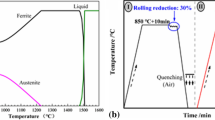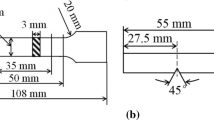In this study, the phenomenon of hydrogen-induced delayed fracture of two cold-rolled DP980 steels with different chemical compositions was studied. The results show that the microstructure of both steels is composed of ferrite matrix, martensite-austenite islands and small amount of bainite. DP980-1 having higher contents of C and Si exhibits higher tensile strength, lower yield strength and higher elongation in comparison with DP980-2 having lower contents of C and Si. According to the results of slow strain rate tensile tests, the tensile strength of DP980-1 after hydrogen charging is reduced by 20.8%, while it is just 5.4% for DP980-2. Moreover, very fine dimples can still be observed in the fracture surface of DP980-2 after hydrogen charging, which indicates a good ductile. The main reasons leading to the better delayed fracture resistance of DP980-2 are the lower volume fraction of martensite-austenite islands, lower content of diffusible hydrogen and the grain refinement effects.









Similar content being viewed by others
References
N. Saeidi, F. Ashrafizadeh, B. Niroumand, and F. Barlat, EBSD Study of Micromechanisms Involved in High Deformation Ability of DP Steels, Mater. Des., 2015, 87, p 130–137
S. Zhang, Y. Huang, B. Sun, Q. Liao, H. Lu, B. Jian, H. Mohrbacher, W. Zhang, A. Guo, and Y. Zhang, Effect of Nb on Hydrogen-Induced Delayed Fracture in High Strength Hot Stamping Steels, Mater. Sci. Eng. A, 2015, 626, p 136–143
F.C. Zhang, X.Y. Long, J. Kang, D. Cao, and B. Lv, Cyclic Deformation Behaviors of a High Strength Carbide-Free Bainitic Steel, Mater. Des., 2016, 94, p 1–8
H. Springer, M. Belde, and D. Raabe, Combinatorial Design of Transitory Constitution Steels: Coupling High Strength with Inherent Formability and Weldability Through Sequenced Austenite Stability, Mater. Des., 2016, 90, p 1100–1109
S.K. Paul, Real Microstructure Based Micromechanical Model to Simulate Microstructural Level Deformation Behavior and Failure Initiation in DP 590 Steel, Mater. Des., 2013, 44, p 397–406
A. Ramazani, Y. Chang, and U. Prahl, Characterization and Modeling of Failure Initiation in Bainite-Aided DP Steel, Adv. Eng. Mater., 2014, 16, p 1370–1380
J. Hu, L.X. Du, J.J. Wang, C.R. Gao, T.Z. Yang, A.Y. Wang, and R.D.K. Misra, Microstructures and Mechanical Properties of a New as-Hot-Rolled High-Strength DP Steel Subjected to Different Cooling Schedules, Metal. Mater. Trans. A, 2013, 44, p 4937–4947
S.Y.P. Allain, O. Bouaziz, I. Pushkareva, and C.P. Scott, Towards the Microstructure Design of DP Steels: A Generic Size-Sensitive Mean-Field Mechanical Model, Mater. Sci. Eng. A, 2015, 637, p 222–234
N. Winzer, O. Rott, R. Thiessen, I. Thomas, K. Mraczek, T. Höche, L. Wright, and M. Mrovec, Hydrogen Diffusion and Trapping in Ti-Modified Advanced High Strength Steels, Mater. Des., 2016, 92, p 450–461
A. Zinbi and A. Bouchou, Hydrogen-Induced Delayed Cracking in the AISI, 301 Unstable Austenitic Steel Sheet, Mater. Des., 2010, 31, p 3989–3995
C. Zhang, Y. Liu, C. Jiang, and J. Xiao, Effects of Niobium and Vanadium on Hydrogen-Induced Delayed Fracture in High Strength Spring Steel, J. Iron. Steel Res. Int., 2011, 18, p 49–53
K.H. So, J.S. Kim, Y.S. Chun, K.T. Park, Y.K. Lee, and C.S. Lee, Hydrogen Delayed Fracture Properties and Internal Hydrogen Behavior of a Fe-18Mn-1.5Al-0.6C TWIP Steel, ISIJ Int., 2009, 49, p 1952–1959
T. Depover, E. Wallaert, and K. Verbeken, Fractographic Analysis of the Role of Hydrogen Diffusion on the Hydrogen Embrittlement Susceptibility of DP Steel, Mater. Sci. Eng. A, 2016, 649, p 201–208
X. Shi, W. Yan, W. Wang, Y. Shan, and K. Yang, Novel Cu-Bearing High-Strength Pipeline Steels with Excellent Resistance to Hydrogen-Induced Cracking, Mater. Des., 2016, 92, p 300–305
A. Laureys, T. Depover, R. Petrov, and K. Verbeken, Microstructural Characterization of Hydrogen Induced Cracking in TRIP-Assisted Steel by EBSD, Mate. Charact., 2016, 112, p 169–179
T. Depover, E. Wallaert, and K. Verbeken, On the Synergy of Diffusible Hydrogen Content and Hydrogen Diffusivity in the Mechanical Degradation of Laboratory Cast Fe-C Alloys, Mater. Sci. Eng. A, 2016, 664, p 195–205
E. Akiyama, K. Matsukado, M. Wang, and K. Tsuzaki, Evaluation of Hydrogen Entry into High Strength Steel Under Atmospheric Corrosion, Corros. Sci., 2010, 52, p 2758–2765
H.U. Hong, J.B. Lee, and H.J. Choi, Improvement of Resistance to Hydrogen Induced Cracking in Electric Resistance Welded Pipes Fabricated with Slit Coils, Met. Mater. Int., 2009, 15, p 133–139
J. Takahashi, K. Kawakami, and Y. Kobayashi, The First Direct Observation of Hydrogen Trapping Sites in TiC Precipitation-Hardening Steel Through Atom Probe Tomography, Scripta Mater., 2010, 63, p 261–264
K. Kawakami and T. Matsumiya, Numerical Analysis of Hydrogen Trap State by TiC and V4C3 in bcc-Fe, ISIJ Int., 2012, 52, p 1693–1697
B.A. Szost, R.H. Vegter, and P.E.J. Rivera-Díaz-del-Castillo, Hydrogen-Trapping Mechanisms in Nanostructured Steels, Metall. Mater. Trans. A, 2013, 44, p 4542–4550
F.G. Wei and K. Tsuzaki, Quantitative Analysis on Hydrogen Trapping of TiC Particles in Steel, Metall. Mater. Trans. A, 2006, 37A, p 331–353
A.B. Hadžipašić, J. Malina, and M. Malina, The Influence of Microstructure on Hydrogen Diffusion and Embrittlement of Multiphase Fine-Grained Steels with Increased Plasticity and Strength, Chem. Biochem. Eng. Q., 2011, 25, p 159–169
M. Masoumi, L.P.M. Santos, I.N. Bastos, S.S.M. Tavares, M.J.G. da Silva, and H.F.G. de Abreu, Texture and Grain Boundary Study in High Strength Fe-18Ni-Co Steel Related to Hydrogen Embrittlement, Mater. Des., 2016, 91, p 90–97
Author information
Authors and Affiliations
Corresponding author
Rights and permissions
About this article
Cite this article
Han, Y., Chen, L., Kuang, S. et al. Investigation on Hydrogen-Induced Delayed Fracture of Cold-Rolled DP980 Steels. J. of Materi Eng and Perform 26, 2024–2031 (2017). https://doi.org/10.1007/s11665-017-2636-4
Received:
Revised:
Published:
Issue Date:
DOI: https://doi.org/10.1007/s11665-017-2636-4




